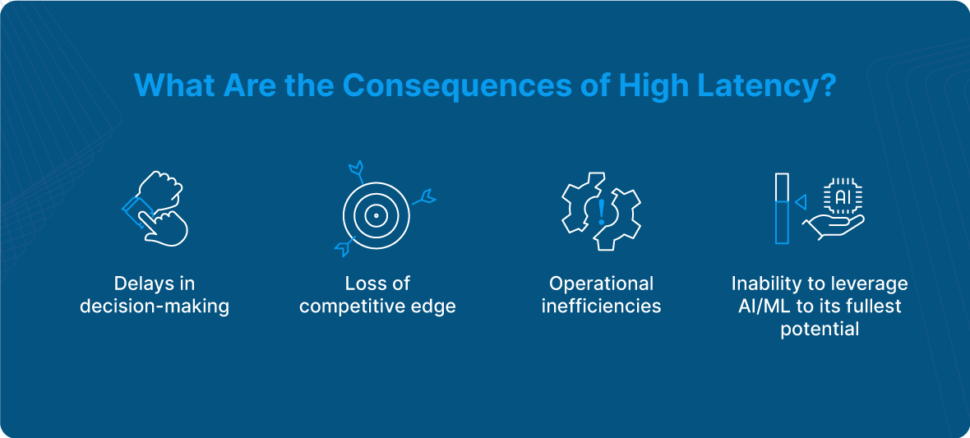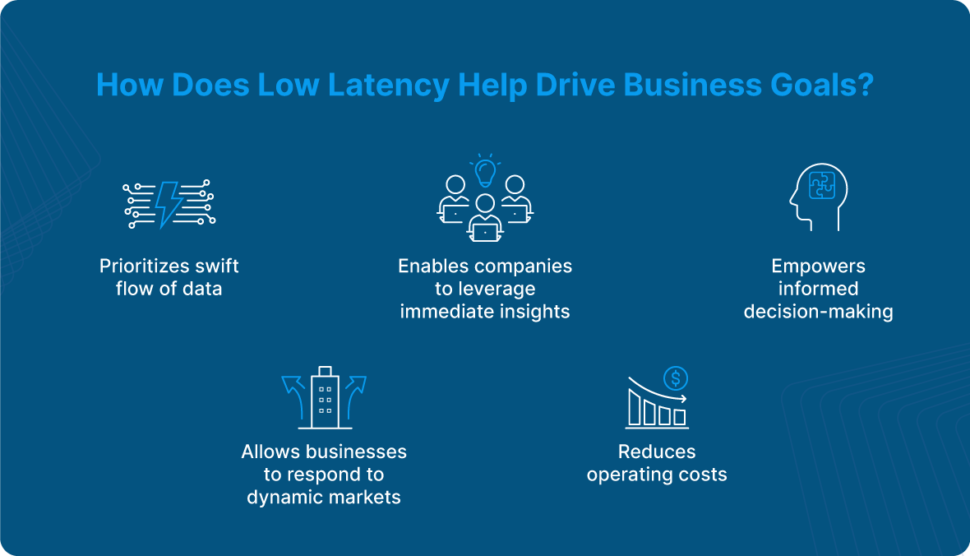Understanding Latency in Real-Time Data Integration + Streaming
Low latency in real-time data integration is paramount for facilitating the swift flow of data through the pipeline. Here’s what you need to know.
- Low latency involves rapid data movement through the data pipeline, covering extraction, transformation, and loading phases. Congestion or inefficient extraction from source systems such as databases, enterprise resource planning systems, IoT devices, or customer relationship management software can introduce latency during the initial extraction phase.
- Delays may occur in the transformation stage if data cleaning, enrichment, and formatting processes are not optimized. Inefficient data transfer protocols or high data volumes can exacerbate latency during the loading phase.
- In real-time data streaming, latency refers to the delay between data generation and consumption or analysis. Technical factors contributing to latency include network congestion, leading to data packet queuing or retransmission. Processing overhead processes like data compression/decompression or serialization/deserialization also impact latency.
- The volume of data itself can overwhelm processing capabilities, particularly in batch processing, which is slower than real-time processing.
What are the Consequences of High-Latency?
High latency, or delays in data processing and transmission, can result in major repercussions for businesses across various fronts. Here’s how high latency can contribute to decision-making lags and other detrimental effects:
- Delays in decision-making: High latency delays access to critical data, meaning decision-makers must rely on outdated or incomplete information. This may result in missed opportunities or poor choices.
- Loss of competitive edge: High latency results in a loss of agility. Competitors with access to complete, timely data can gain a competitive advantage over businesses struggling with latency issues.
- Operational inefficiencies: Delayed data transmission results in operational processing disruptions. For instance, in the healthcare industry, high latency can hinder healthcare providers’ ability to access critical patient information in a timely manner. This may result in treatment delays.
- Inability to leverage AI/ML to its fullest potential: Because artificial intelligence and machine learning algorithms heavily lean on large volumes of real-time data to generate insights, your business is unable to use these technologies to their fullest potential without low latency data integration and streaming.

How Does Low-Latency Contribute to a Successful Data Strategy?
Low latency is critical to enable real-time data analysis, which form the foundation of agile decision-making and operational efficiency. Ensuring prompt access to accurate insights is imperative for organizations to respond decisively to rapidly changing conditions, which is impossible with high latency.
From a technical standpoint, minimizing latency across the data pipeline requires optimizing various components, such as data ingestion, storage, processing, and retrieval, through the adoption of distributed computing frameworks, high-speed networking technologies, and in-memory caching solutions. The way that you can do so is by harnessing real-time data processing over batch processing methodologies. This allows your organization to streamline data flows, reduce processing times, and facilitate seamless decision-making processes.
Consequently, regardless of the comprehensiveness of your organization’s data strategy, bottlenecks that occur as a result of high latency will hinder your organization’s ability to fully leverage its data assets and realize the associated benefits.
How Low Latency Helps Drive Business Goals
Low latency isn’t just desirable from a technical standpoint—it’s a transformative factor for your business in achieving its goals. By prioritizing the swift flow of data through the pipeline, companies can leverage immediate insights to make well-informed, data-driven decisions swiftly and efficiently.
Low latency enables your business to respond to rapidly changing market dynamics and customer needs, all while making decisions buoyed by data. This offers a significant competitive advantage.
Streamlined data processing also offers operational efficiency a boost. By reducing bottlenecks and accelerating response times, your organization is able to use its resources more efficiently, which results in lower operational costs. Moreover, real-time data analysis enables your team to identify and mitigate potential risks rapidly.
Leveraging Striim to Optimize Data Integration and Streaming Processes
By leveraging Striim’s Change Data Capture (CDC) technology, your team can monitor and capture incremental changes in real-time from your source systems. Striim taps into your source database transaction logs, which record every transaction and change made to the database.
Striim reads these logs and captures data changes without imposing additional load on the database.
Since these changes are captured incrementally, Striim processes only the data that has changed since the last capture. This significantly reduces the volume of data to be processed and transmitted, thereby minimizing latency.
Furthermore, Striim’s optimized data transmission protocols and distributed architecture minimize network congestion, ensuring reliable data flow. Additionally, Striim performs in-flight transformations during data ingestion, reducing processing overhead. This comprehensive approach results in low-latency data streaming, optimal for timely consumption and analysis.
Ready to unlock a new era of seamless data integration and streaming? Get a free trial and discover how Striim can help you make data impactful the moment it is born.






















